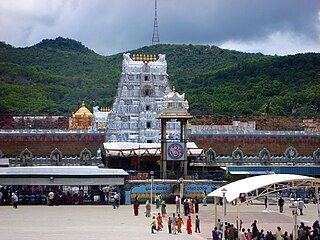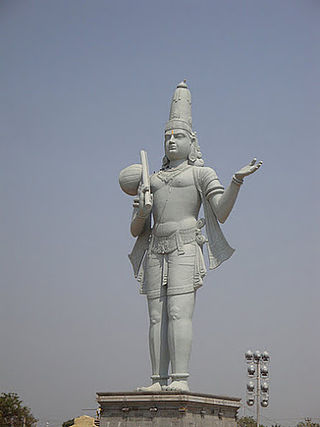
Chittoor is a city and district headquarters in Chittoor district of the Indian state of Andhra Pradesh. It is also the mandal and divisional headquarters of Chittoor mandal and Chittoor revenue division respectively. The city has a population of 153,756 and that of the agglomeration is 175,647.

Chittoor district is one of the eight districts in the Rayalaseema region of the Indian state of Andhra Pradesh. It had a population of 18,72,951 at the 2011 census of India. It is a major market centre for mangoes, grains, sugarcane, and peanuts. The district headquarters is at Chittoor City.
Narayanavanam is a census town in Tirupati district of the Indian state of Andhra Pradesh. It is the headquarters of Narayanavanam mandal in Sri Kalahasti revenue division. The town is known for Kalyana Venkateswara Temple dedicated to Lord Venkateswara and constructed in 1541 AD.
Pallipattu is a town in Tamil Nadu and a border town located between the Chittoor District of Andhra Pradesh and Tiruvallur District of Tamil Nadu. It is known for its fertile agricultural lands and the west-to-east flowing Kusasthalai river.

Puttur is a town in Tirupati district of the Indian state of Andhra Pradesh. It is the mandal headquarters of Puttur mandal in Tirupati revenue division. It is known for a traditional method of splinting/bandaging bone fractures.

Pakala is a town in Tirupati district of the Indian state of Andhra Pradesh. It is the mandal headquarters of Pakala mandal. It comes under Tirupati revenue division.
Kankipadu is a suburb of Vijayawada and a in Krishna District of the Indian state of Andhra Pradesh. It is also the mandal headquarters of Kankipadu mandal in Vuyyuru revenue division.

Narasannapeta is a census town in Srikakulam district of the Indian state of Andhra Pradesh. It is the mandal headquarters of Narasannapeta mandal in Srikakulam revenue division. 43 villages are there under the administrative division of Narasannapeta.
Duttalur or Duthalur is a village and a mandal in Nellore district in the state of Andhra Pradesh in India.
Srirangarajapuram is a village in Chittoor district of the Indian state of Andhra Pradesh. It is the mandal headquarters of Srirangarajapuram mandal.
Addanki is a Municipal city in Bapatla district of the Indian State, Andhra Pradesh. Addanki North is the mandal headquarters of Addanki mandal in Addanki revenue division.
Talakona is situated in Tirupati district of Andhra Pradesh, India. It is a resort with waterfalls, dense forests and wildlife. Talakona waterfall is in Sri Venkateswara National Park, Tirupati district of Andhra Pradesh. With a 270 feet (82 m)-fall, Talakona is the highest waterfall in Andhra Pradesh state. Talakona is also known for the Lord Siddheswara Swamy Temple, which is located close to the waterfall.

Gali Muddu Krishnama Naidu was an Indian politician from Andhra Pradesh. He served as Minister of Higher Education, Andhra Pradesh. He was elected for a record six terms to the Andhra Pradesh Legislative Assembly, five times from the former Puttur constituency and once from the Nagari constituency.
Pachikapalam or Pachikapallam is a village and a Subdivisions of India in Chittoor district in the state of Andhra Pradesh in India.
Kollagunta is a village in Chittoor district of the Indian state of Andhra Pradesh. It is located in Karvetinagar mandal.kollagunta village situated exactly at Andhrapradesh and Tamil Nadu Border.
The Arani, also known as Araniar or Araniyar, is a 108 km long river in India. It flows through the states of Tamil Nadu and Andhra Pradesh.
Puttur Assembly constituency was an assembly constituency of the Madras Legislative Assembly till States Reorganisation Act, 1956 Andhra Pradesh Legislative Assembly, India. It was one of constituencies in the Chittoor district.

Tirupati district is one of the eight districts of Rayalaseema region in the Indian state of Andhra Pradesh. The district headquarters is located at Tirupati city. This district is known for its numerous historic temples, including the Hindu shrine of Tirumala Venkateswara Temple and Sri Kalahasteeswara temple. The district is also home to Satish Dhawan Space Centre, a rocket launch centre located in Sriharikota. The river Swarnamukhi flows through Tirupati, Srikalahasti, Naidupeta, Vakadu and join into the Bay of Bengal.

Annamayya district is one of the eight districts in the Rayalaseema region of Andhra Pradesh, established in 2022. Rayachoti is the district administrative headquarters, and Madanapalle is the most populated city in the district.
Puttur mandal is one of the 34 mandals in Tirupati district of Andhra Pradesh in India. It has its headquarters at Puttur town and is part of Tirupati revenue division.








